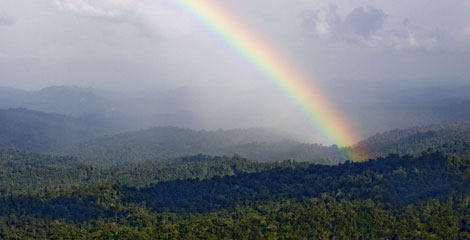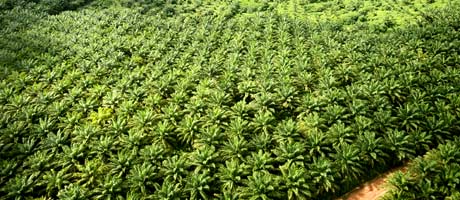I am happy to welcome Jamie from Greenpeace who will be contributing occasional articles to The Sietch.

Normally, the view from my office window is similar to those from many others – there are a few trees, stretches of terraced roofs and a smattering of landmarks (in my case, some of London’s taller financial institutions). For the past few weeks, however, it’s been somewhat different – smooth warm seas, lush tropical islands and the occasional fishing boat drifting by. I am working, honest, but my office space has shifted through 13,500 km, nine time zones and flipped to the other side of the equator.
I work for Greenpeace in the UK, producing web content and helping to develop our online campaigns, but I’m currently floating somewhere off Java in one of our ships, the Esperanza. After sending the Naib an email begging for some promotion for the blog I’m writing, he went several steps further and generously invited me to plug both it and the work we’re doing myself.
We’re currently two-thirds of the way through a three-month tour of south-east Asia – six weeks in Papua New Guinea, six weeks travelling the length of Indonesia – and what we’re interested in are the remaining areas of pristine forest to be found here. It’s becoming increasingly apparent that industrial logging and a stable climate are mutually exclusive, so protecting the forests we have is a no-brainer in the climate change argument.
Brace yourself now, I’m going to dazzle you with some statistics:
- we’ve already lost 80 per cent of the planet’s original forest cover; most of that has been gobbled up within the last 30-odd years;
- around one-fifth of our greenhouse gas emissions are thanks to deforestation;
- Indonesia ranks only behind the US and China in terms of man-made greenhouse gas emissions, and that’s largely down to the clearance of its rainforests and carbon-rich peatlands.
Join the dots and it’s obvious there’s a big, big problem.
In Papua New Guinea, the focus was on illegal logging but now we’ve moved on to one of the biggest threats facing Indonesia’s forests: the ever-expanding palm oil industry. Other writers on this blog have already covered both the problems with palm oil and some of our earlier work on the subject.
Palm oil is bad for the forests around here because the industry’s dizzying expansion is chewing up colossal areas of forest to convert into plantations. These vast monocultures stretch for mile after mile, making Indonesia the largest producer in the world. But that’s not enough, and it’s set to expand even more. Large chunks of the forest that remains are pegged for the palm oil treatment with companies you’ve probably never heard of (like Sinar Mas, Duta Palma and Asian Agri) poised to carve them up.
So, what’s the plan? The purpose of sailing from Papua in the east to Sumatra in the west is to see what’s happening in the forests ourselves. Over the past three weeks, we’ve been flying out over the forests of Indonesian New Guinea in the Esperanza’s helicopter (known to her friends as Tweety) and the good news is there’s still a lot of gorgeous forest out there. I managed to sneak on one of the flights myself and I don’t think I’m exaggerating when I say it ranks up there in the top ten highlights of my life so far.
There’s bad news too, and we also saw plenty of evidence that destruction is on its way. Loggers have cut roads through the forest, companies are logging illegally (we caught some in the act), and there’s a significant amount of landbanking going on, with palm oil companies staking their claims on huge areas, waiting for the right time to move in. To catch a glimpse of what the helicopter team spied, watch this video:
During our stops in Jayapura and Manokwari, we’ve also been meeting a lot of people from other organisations and community groups across the region. The forests won’t be protected by one organisation alone and we have to work together – international big boys and small village collectives alike – to succeed.
And we have friends in high places – the governors of both Papua and West Papua are big forest fans. While they’re not anti-palm oil, they want all developments to be made sympathetically, both with the environment and the rights of indigenous Papuans which have more often than not been trampled in the rush for forest riches. Barnabas Suebu, governor of Papua, has even installed a log export ban, making it very difficult for clearances to begin. The logging companies commissioned to clear the forest make their money on the sale of the timber they fell, so if they can’t get that timber out of Papua, there’s no incentive for them to move in. And so for the time being, the forest remains more or less in place.

You can catch up on all our adventures in New Guinea on the Forests For Climate blog, as we’ve now left the island behind and are currently en route to Java and the capital, Jakarta. After a few days there, we’ll be moving on to Sumatra where, unlike New Guinea, palm oil has taken a firm hold. Most of the Sumatran forests are gone, but a few critical patches remain. Some of that sits on top of swampy, boggy peatland which is being drained and burnt – draining the peat releases ludicrous amounts of greenhouse gases; burning it pumps out even more.
There’s a province in Sumatra called Riau which still contains an area of peatland that, relatively speaking, isn’t massive – it’s about the size of Switzerland or Taiwan – but it’s chock full of carbon. So much, in fact, that there’s an entire year’s worth of global emissions just waiting to be unleashed.
I’ve waffled on far longer than I intended – there’s a lot to cover and I haven’t even mentioned the Roundtable on Sustainable Palm Oil or why in, its current state, it’s providing a fine coat of greenwash for its members. Or the cunning plan we have for an international funding mechanism that will actually get richer countries paying to help protect forests around the world.
I’ll leave all that for next time with an update from Jakarta. In the meantime, some more quick plugs for the Esperanza’s Twitter feed and Google Earth layer (download the KMZ file), and an email writing campaign aimed at Indonesia’s president, Susilo Bambang Yudhoyono – it will take two minutes to complete but could make all the difference in the world.